The Rocky Mountains are the most significant mountain range in North America. They form a 3,000-mile straight line through six states from British Columbia, Canada, to New Mexico. Their system formed 80 million years ago from tectonic plates sliding underneath each other and glacier erosion during the last ice age.
The Rocky Mountains have many biotic and climactic zones, leading to extremely diverse wildlife and habitats. Find out eight snakes that live in the Rocky Mountains and discover their unique habitats. Plus, learn if any of them are venomous.
1. Western Diamondback Rattlesnake

Western diamondback rattlesnakes live in the steep rocky canyons of the Rocky Mountains.
©Alexander Wong/Shutterstock.com
The western diamondback rattlesnake is a venomous pit viper snake native to the Southwestern United States and Mexico. It lives in the steep rocky canyons of the Rocky Mountains up to 6,500 feet, basking in the sun during summer or hibernating in caves during winter.
Western diamondback rattlesnakes account for the most significant number of snake bites in the US, releasing a proteolytic venom that destroys tissue, whether animal or human. Their venom is less toxic than other rattlesnakes, but their large specialized fangs allow them to deliver enormous amounts of toxin with a single bite. Untreated bites have a 10 to 20% mortality rate. Seek medical attention immediately if bitten by a western diamondback rattlesnake. It is the most dangerous snake that lives in the Rocky Mountains.
2. Western Ground Snake
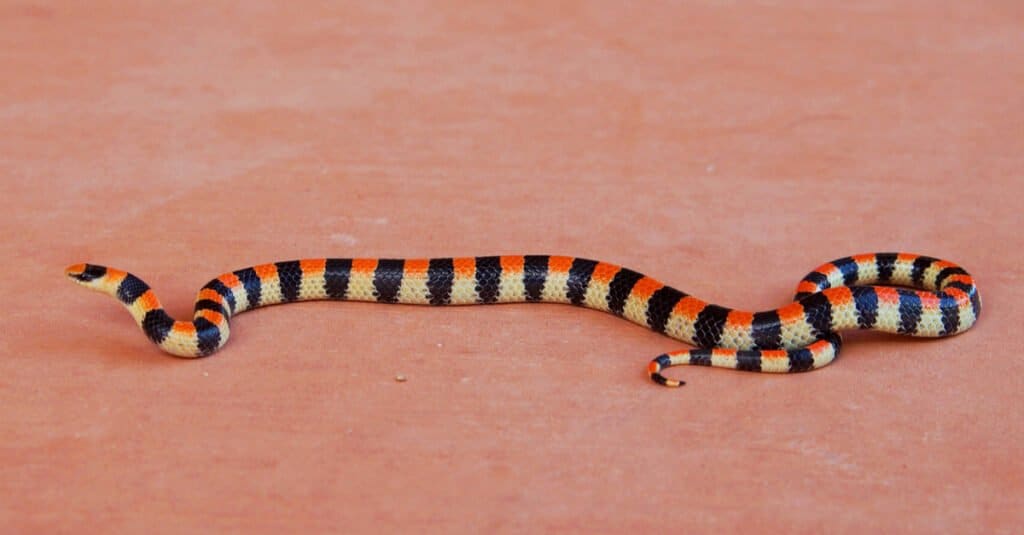
Western ground snakes prefer arid habitats in the Southwest.
©Matt Jeppson/Shutterstock.com
Also known as common ground snakes, these snakes are small, harmless, and endemic to North America. Their appearance, especially their coloration, varies widely depending on their location, ranging from black, red, brown, and orange.
They like dry, rocky areas, mainly in the Southwest. Arid habitats are their environments of choice, and you can find them on canyon rims or in low-desert shrubs. These secretive creatures are nocturnal, waiting for the cover of darkness to venture out for food. Their diet consists of scorpions, spiders, centipedes, and crickets.
3. Great Plains Rat Snake
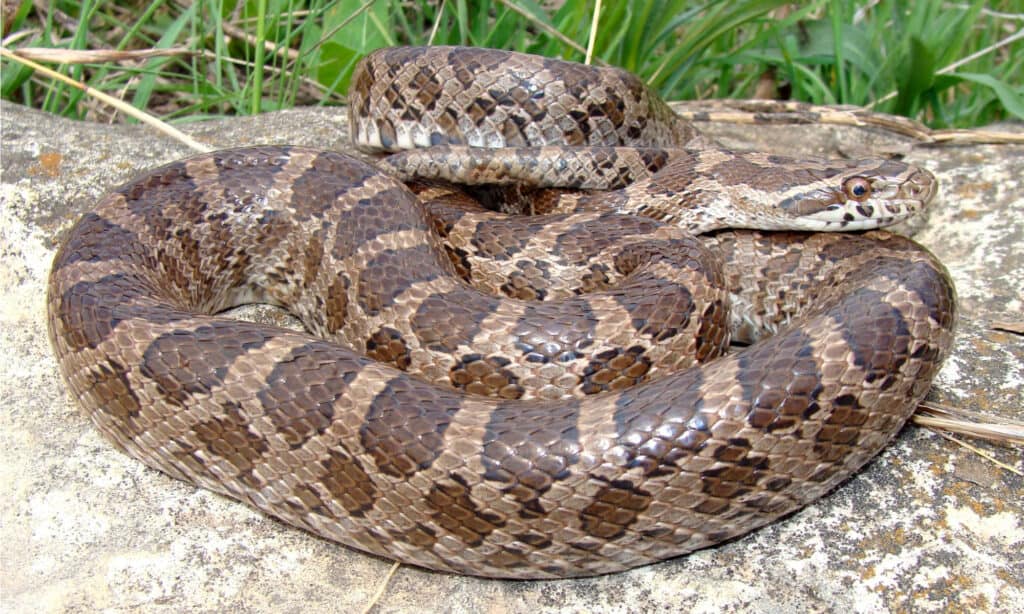
Great Plains rat snakes live in rocky areas, grasslands, and coastal plains.
©Matt Jeppson/Shutterstock.com
Great Plains rat snakes are nonvenomous snakes native to the Central United States and Northern Mexico, mainly inhabiting the Rocky Mountains in Colorado. They live in rocky mountain areas but also take residence in open grasslands, light forests, and coastal plains.
These rat snakes eat rodents, and you can often find them in rural areas near farms, taking advantage of the abundant mice and rats. They use constriction instead of venom for subduing prey, making them harmless to humans.
4. Ring-Necked Snake
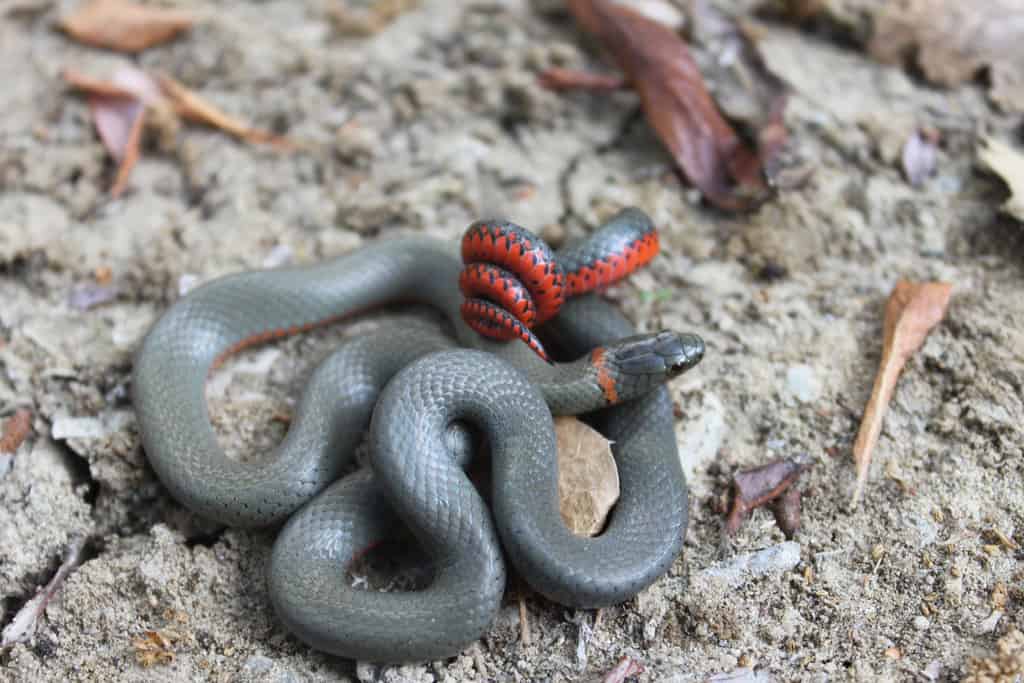
The ringneck snake likes to hide in moist soil in woodlands near rocky hillsides.
©Mark Herr / CC BY-SA 3.0 – License
The ring-necked snake is another harmless snake native to the United States, Central Mexico, and Southeastern Canada. On its dorsal side is brown, black, olive, or smoky gray with bright yellow, orange, or red on its undersides.
Ringneck snakes are woodland snakes and like to hide in moist soil under wood and rocks, sometimes burrowing in the ground. You will most often find these snakes in woodlands near rocky hillsides in riparian and wet environments. These snakes are secretive and don’t like to be around humans, but you will occasionally see them taking refuge in artificial structures to hide from predators.
5. Great Basin Gopher Snake
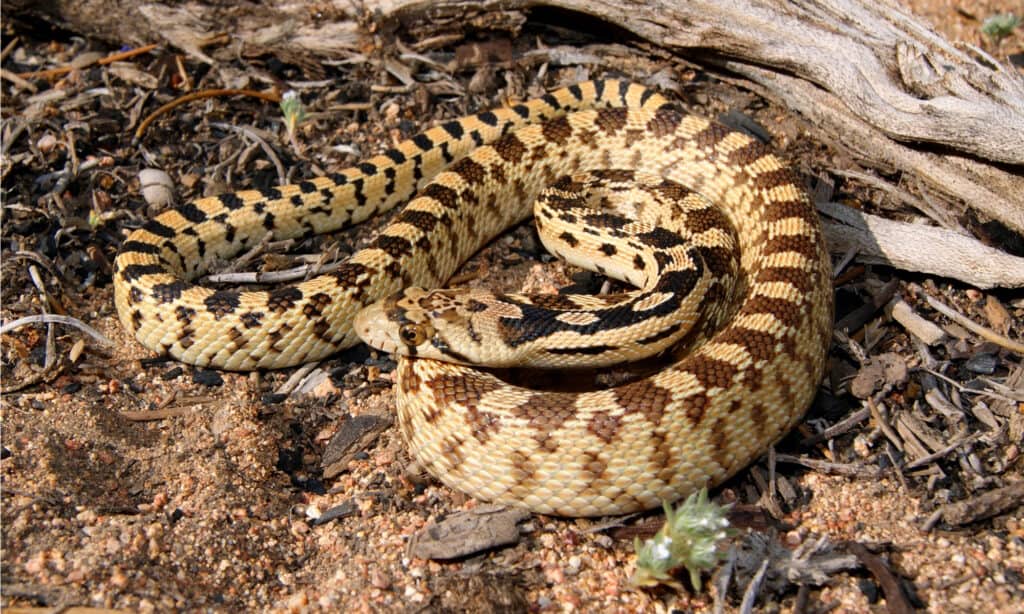
Great Basin gopher snakes inhabit grasslands and woodlands in the Western United States.
©Matt Jeppson/Shutterstock.com
This subspecies of snake is nonvenomous and native to the Western United States and Southwestern Canada. The Great Basin gopher snake lives in most states where the Rockies intersect in grasslands, woodlands, deserts, agricultural areas, and riparian environments.
Great Basin gopher snakes are excellent climbers and swimmers and are most commonly seen when hiking trails near the mountains. You can spot them by their pointed heads and cream-colored bodies with dark markings. They mimic the sound of rattlesnakes and make lots of hissing noises when confronted, but they are harmless to humans and pets.
6. Bullsnake
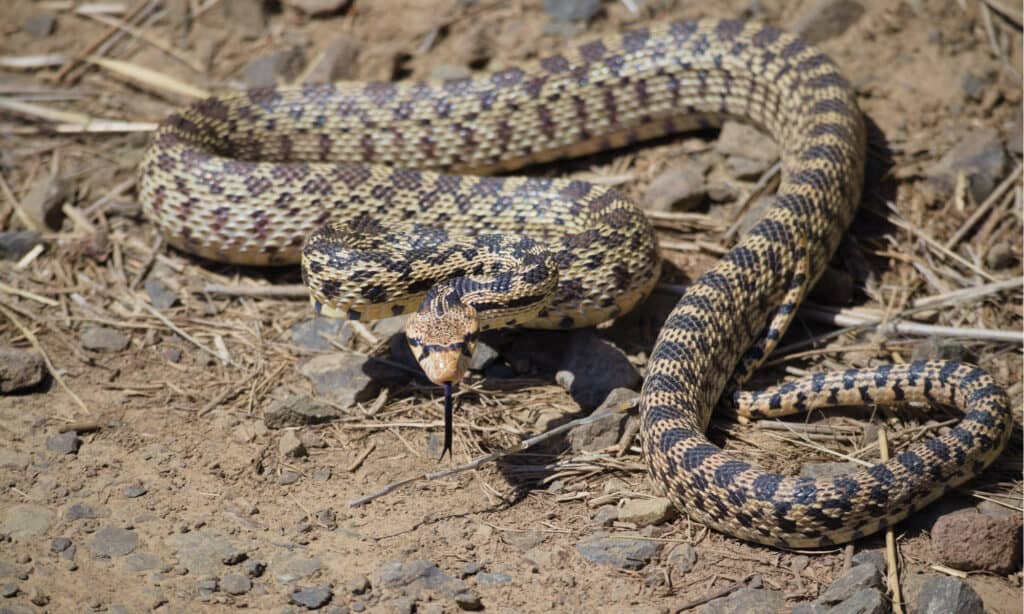
The bullsnake lives in various environments in the Midwest Great Plains.
©Christopher Joe Brown/Shutterstock.com
The bullsnake is a nonvenomous subspecies of a gopher snake. It is one of the largest in North America, reaching a length of 8 feet. You can find bullsnakes in Mexico and Canada, but most often, they live in the Great Plains. They inhabit coniferous forests, farmland, woodland, and grassland in many areas near the Rocky Mountains.
Most bullsnakes are pretty defensive. When threatened by humans, they will make themselves look large and begin hissing and lunging while retreating. They often do this because they can’t move fast due to their large size. They look similar to rattlesnakes and give people a scare when out hiking, but they are harmless.
7. Western Coachwhip
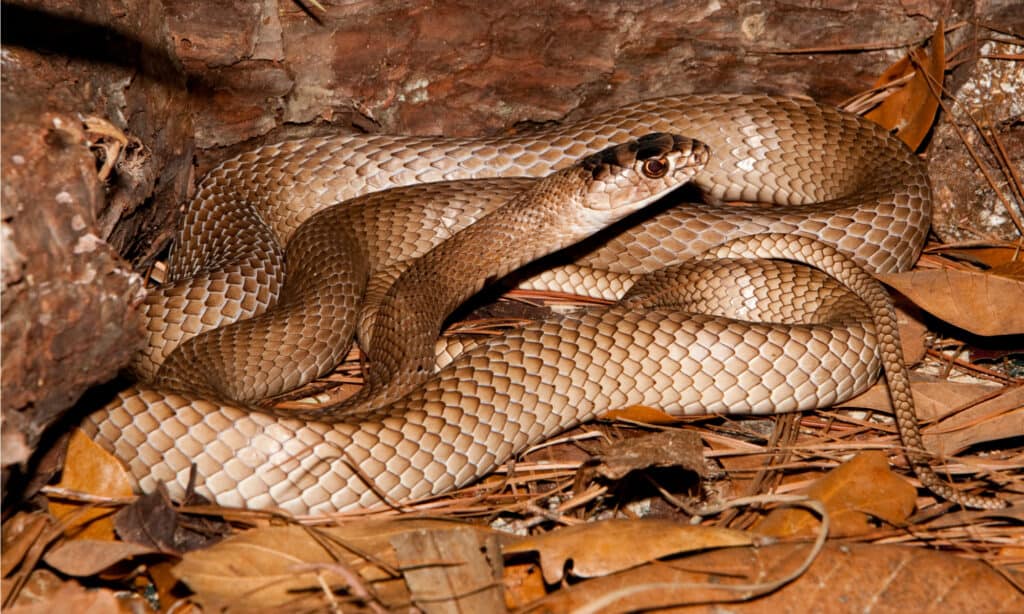
Coachwhip snakes are widespread throughout the United States.
©Jay Ondreicka/Shutterstock.com
Coachwhips, also known as whip snakes, are nonvenomous snakes endemic to the United States and Mexico. They are widespread, and you can find them from coast to coast throughout the country. They live in open areas like pine forests, old fields, and prairies, where they can slither in sandy soil.
These diurnal snakes are extremely fast, moving up to four miles per hour, and they typically bolt at the first sign of trouble. But if you corner them, they will strike without hesitation. Their bites are painful but relatively harmless unless it gets infected (which can happen with any wound). If you’re hiking, look for their little heads popping up in the grass or behind rocks. Western coachwhips are curious creatures with fantastic eyesight, often checking their surroundings for predators.
8. Western Ribbon Snake
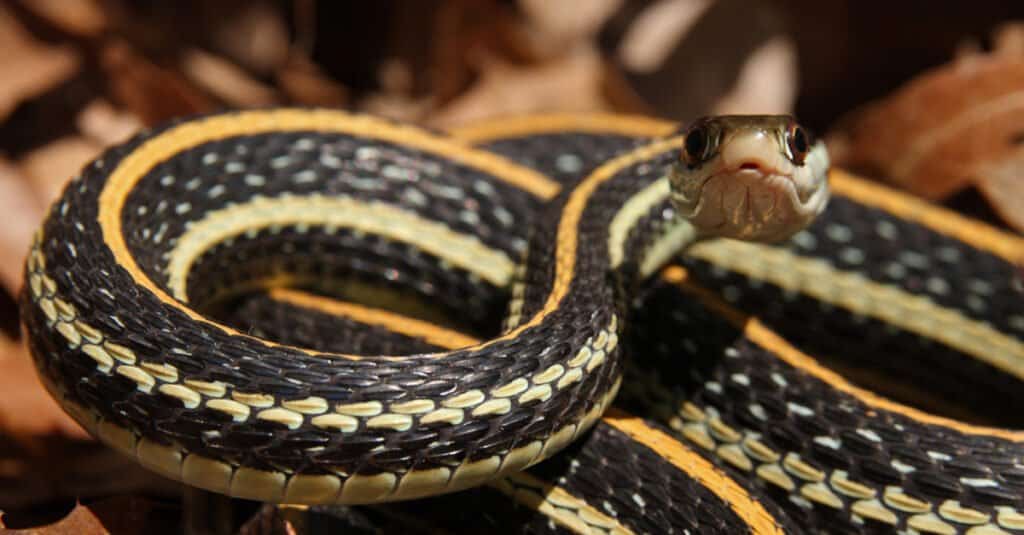
Western ribbon snakes are aquatic and often found near ponds, rivers, and lakes.
©Ryan M. Bolton/Shutterstock.com
Western ribbon snakes are garter snakes endemic to the Western United States, Mexico, and Central America. These medium-sized snakes are slender with long tails and have black, brown, or olive coloring and light-colored stripes.
These nonvenomous snakes are aquatic, often near ponds, marshes, rivers, and lakes. They are fast and skim the water’s surface effortlessly, but they can also climb well and bask near the water’s edge. When confronted, they are less likely to bite than other garter snakes. Instead, they will thrash around and emit a foul musk.
Up Next:
The photo featured at the top of this post is © steve estvanik/Shutterstock.com
Discover the "Monster" Snake 5X Bigger than an Anaconda
Every day A-Z Animals sends out some of the most incredible facts in the world from our free newsletter. Want to discover the 10 most beautiful snakes in the world, a "snake island" where you're never more than 3 feet from danger, or a "monster" snake 5X larger than an anaconda? Then sign up right now and you'll start receiving our daily newsletter absolutely free.
Thank you for reading! Have some feedback for us? Contact the AZ Animals editorial team.







